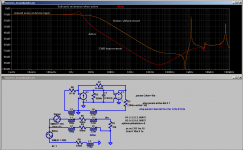Almost in Dutch? I know we were admonished here, years ago, when we did not use English only. Why so many Prague districts in your post?
Membership has its privileges ....
Besides the two possibilities that have been put on the table so far, there's another one. One camp so far has called these "inventors" charlatans. The other camp called them misunderstood scientists. However, they could just be living a delusion. There is no shortage of people who live in a world of their own. I knew a guy who had a certain mental deviation which I will not name. He could talk for hours about the most amazing stuff, and all made sense and was logically connected. But there was always something that felt off, no matter how believable his stories were.
I'm not saying this is the case with Bybee. Just wanted to be thorough and cover all the possibilities.
I'm not saying this is the case with Bybee. Just wanted to be thorough and cover all the possibilities.
how different
Likely a bit hard for you to understand, but even in a place as small as Cheesica, there are several languages.
Part of the folks up north speak a lingo that's related to Scandinavian languages, most have little difficulty to understand Danish.
Frisian languages - Wikipedia, the free encyclopedia
Way down south to the east, folks speak half German, half their own thing.
Lingo of the center south is half Belgian, takes a marginal effort to understand flat Antwerp dialect.
People from the west (Amsterdam, Rotterdam, The Hague) are not able to understand folks from the north, east, or south.
(few interesting exceptions, e.g. folks from fisherman villages, who still speak the local lingo, require less effort to learn how to speak Danish)
Same deal in other European nations, each has their own Cajun tribes

Thanks Jacco,
That would be a bit annoying I would imagine if you moved about from place to place. Here unless you are from the swamps of Louisiana and have a Cajun dialect I don't think things are anywhere that bad, though it can be a challenge with some New England accents and somewhere in Wisconsin perhaps. I can usually get past most accents here and understand what someone is saying, perhaps TV has had something to do with that? Where I live we hear so many different languages, Los Angeles has a very mixed culture and languages from around the world, but most speak English so we can all communicate.
That would be a bit annoying I would imagine if you moved about from place to place. Here unless you are from the swamps of Louisiana and have a Cajun dialect I don't think things are anywhere that bad, though it can be a challenge with some New England accents and somewhere in Wisconsin perhaps. I can usually get past most accents here and understand what someone is saying, perhaps TV has had something to do with that? Where I live we hear so many different languages, Los Angeles has a very mixed culture and languages from around the world, but most speak English so we can all communicate.
Geordie....
Likely fair hard fo' yee tuh understand, but evon in a place as weeny as cheesica, thor are several languages.
part iv the folks up neerth speak a lingo that's related tuh scandinavian languages, most hev wee difficulty tuh understand danish.
frisian languages - wikipedia, the free encyclopedia.
wa doon syeuth tuh the east, folks speak half german, half their ahn thin.
lingo iv the centor syeuth is half belgian, teks a marginal effort tuh understand flat antwerp dialect.
people from the west (amsterdam, rotterdam, the hague) are neet yeble tuh understand folks from the neerth, east, or syeuth.
(few interestin exceptions, e.g. folks from fisherman villages, whe still speak the local lingo, require less effort tuh learn ha tuh speak danish)
syem deal in othor european nations, each hez their ahn cajun tribes.
Dan.
whoohoo.co.uk - The British Dialect Translator
Likely fair hard fo' yee tuh understand, but evon in a place as weeny as cheesica, thor are several languages.
part iv the folks up neerth speak a lingo that's related tuh scandinavian languages, most hev wee difficulty tuh understand danish.
frisian languages - wikipedia, the free encyclopedia.
wa doon syeuth tuh the east, folks speak half german, half their ahn thin.
lingo iv the centor syeuth is half belgian, teks a marginal effort tuh understand flat antwerp dialect.
people from the west (amsterdam, rotterdam, the hague) are neet yeble tuh understand folks from the neerth, east, or syeuth.
(few interestin exceptions, e.g. folks from fisherman villages, whe still speak the local lingo, require less effort tuh learn ha tuh speak danish)
syem deal in othor european nations, each hez their ahn cajun tribes.
Dan.
whoohoo.co.uk - The British Dialect Translator
Wot yous posted in da house wuz emence useful an' interestin. fank yous!
OK guys, back to circuits.
I devised a technique to kill ground loop currents back in 2008, never did anything about it...(In fact, the bulk of it is in my gallery, the drawing with the magnetic core driving the loop with a toroidal pickup between amp and pre. Use the pickup to drive the core inverted to zero the loop current.)
George provided me a copy of Coaxial Electrical Circuits for Interference-Free Measurements, Shakil Awan, Bryan Kibble, and Jurgen Schurr, IET, 2010
Here is a copy of page 56:
Anybody game to try this on an unbalanced coax input to an audio amplifier? It's auto-ground loop busting without breaking the conductivity of the loop.
Perhaps a group engineering/build?
Edit: Oh, btw, it needs to have a bandwidth of 20Khz at least...
jn
What is the advantage of this over something like this?
http://www.diyaudio.com/forums/construction-tips/251996-ground-loops.html#post3845378
Here is my stab at a simulation, and playing around with the plot annotation feature in LTSpice.
It does what it's intended to, but I think the design could use some refinement and careful implementation. A 25mH CM choke from a computer PSU will break as much of a 60Hz ground fault as a 10R resistor, and if I can remember right, tends to get at least 54db rejection.
I found that if I adjusted the opamp to stop the subsonic resonance, the performance actually became equal or worse than a normal 25mH CM choke. Of course I may be doing something wrong.
EDIT: Also, the opamp drives the choke when the choke isn't doing a good job on its own. This can saturate the opamp. With a 100mA 60Hz ground fault current, drive current is 100mA. At the resonance frequency it spikes to 40 times the ground fault current. So this circuit could easily spend much of it's time in saturation.
It does what it's intended to, but I think the design could use some refinement and careful implementation. A 25mH CM choke from a computer PSU will break as much of a 60Hz ground fault as a 10R resistor, and if I can remember right, tends to get at least 54db rejection.
I found that if I adjusted the opamp to stop the subsonic resonance, the performance actually became equal or worse than a normal 25mH CM choke. Of course I may be doing something wrong.
EDIT: Also, the opamp drives the choke when the choke isn't doing a good job on its own. This can saturate the opamp. With a 100mA 60Hz ground fault current, drive current is 100mA. At the resonance frequency it spikes to 40 times the ground fault current. So this circuit could easily spend much of it's time in saturation.
Attachments
Last edited:
The thing with 'magic' devices, is that once you tune into the sound quality changes that these items typically cause - is that you find almost everything around you, the materials in standard household or workshop items will have an impact, depending upon everything. Therefore - to stop yourself going mad trying to find 'a right balance' of the bits and pieces - then the trick is to make the system totally invulnerable, impervious to such impact ... and in so doing it is highly likely that the SQ will evolve to a very high level ...
Here is my stab at a simulation, and playing around with the plot annotation feature in LTSpice.
The number of turns from the attachment jn posted would suggest that the inductances for each winding in the simulation need some adjustment. 12 to 20 turns for both coax windings should make for roughly equal inductance. i.e. L1=L2=L4=L5. A single conductor wound with 10 turns for L3 or 50 turns for L6 would make for different numbers as well I believe.
Perhaps jn or one of the other knowledgeable members can do a back of the napkin estimate for each winding based on his desired core material to make the target BW?
To get two windings of 12 to 20 turns (one each for L and R on the same core) plus the detector or correction winding it may take a fairly large diameter core. 2.5 inches? 3? I'm making the assumption each coil should be wound isolated from the others, non-overlapping, to reduce normal mode and capacitive coupling.
Last edited:
The 'magic' is in the experience ...Well you do appear to have magic desktop devices Frank...
BTW, good choice on using Phantom for the checking out - a recording that keeps on giving ...
This might be a riddle to some, so beware for those of low tolerance --
In a conductor.... where the flux is more dense in one part than another.... which part has the lowest inductance?
-RNM
Im going to bed.... finish this tomorrow after I get some answers.
In a conductor.... where the flux is more dense in one part than another.... which part has the lowest inductance?
-RNM
Im going to bed.... finish this tomorrow after I get some answers.
Last edited:
- Status
- Not open for further replies.
- Home
- Member Areas
- The Lounge
- John Curl's Blowtorch preamplifier part II



